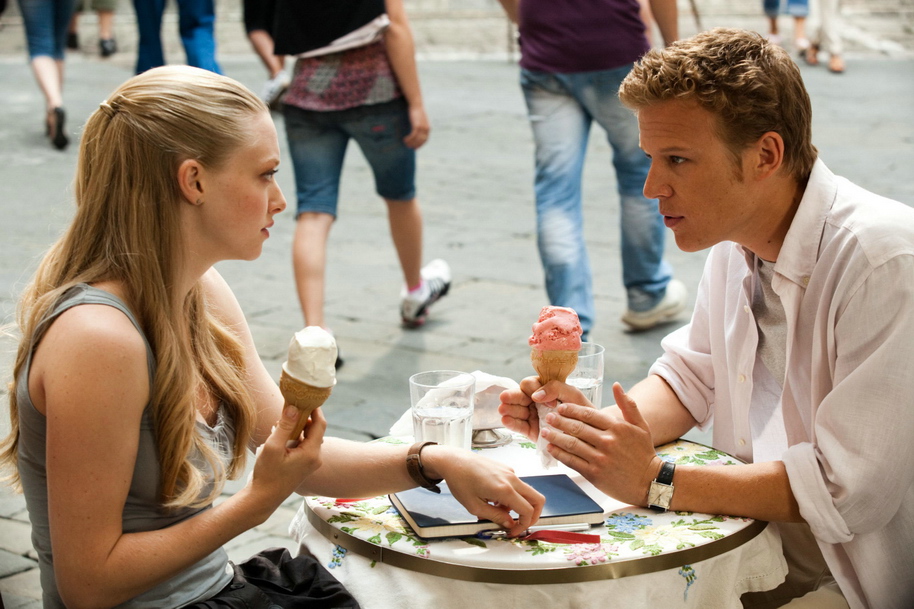
❖❖❖
IN THIS ISSUE
WHY FETTUCCINE ALFREDO IS ONE
THE SIMPLEST GREAT DISHES OF THE WORLD
By John Mariani
NEW YORK CORNER
AU ZA'ATAR
By John Mariani
CAPONE'S GOLD
Chapter 20
By John Mariani
NOTES FROM THE WINE CELLAR
THE PAST, PRESENT AND FUTURE OF
CHÂTEAU DUCRU-BEAUCAILLOU
By John Mariani
❖❖❖
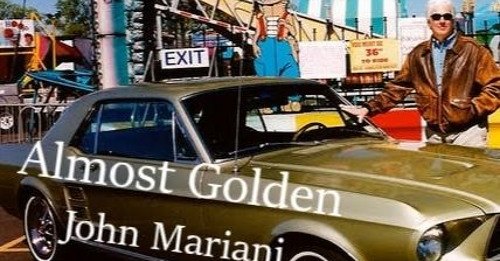 On
this week's episode of my WVOX Radio Show
"Almost Golden," on Wed. August 18 at
11AM EST,I will be interviewing
Westchester
On
this week's episode of my WVOX Radio Show
"Almost Golden," on Wed. August 18 at
11AM EST,I will be interviewing
Westchester 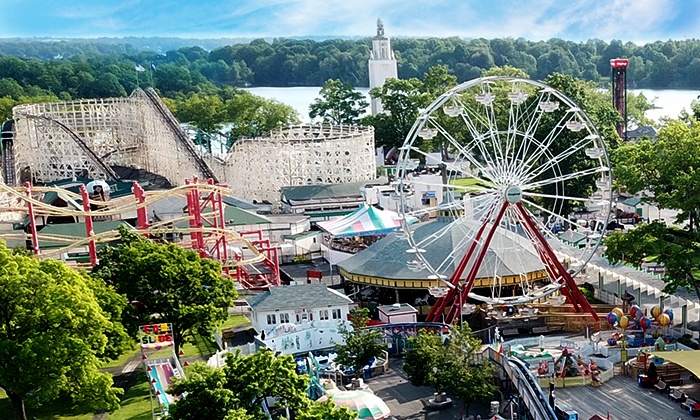 County
Executive George Lattimer about the
historic Rye Playland Park. Go to: WVOX.com.
The episode will also be archived at: almostgolden.
County
Executive George Lattimer about the
historic Rye Playland Park. Go to: WVOX.com.
The episode will also be archived at: almostgolden.
https://youtu.be/vf588K6WJ9E
❖❖❖
WHY FETTUCCINE ALL’ALFREDO IS
ONE
OF THE WORLD’S SIMPLEST GREAT DISHES
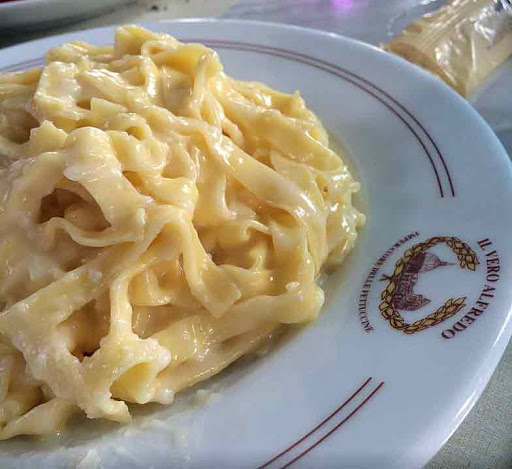
By John Mariani
Signora DiLelio wasn't
hungry. Which was worrisome because she had just
given birth to her son Armando and he needed
Mama's milk. Her husband Alfredo fretted and
fretted, then tried to coax her with a dish of
pasta. And so was fettuccine all'Alfredo created
in 1914.
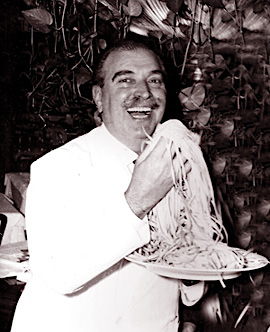 Simplicity,” said Leonardo da Vinci,
“is the ultimate sophistication,” and, with the
possible exception of the Martini, nowhere is
that more the truth than with fettuccine
all’Alfredo, for which we have an origins
story, so we know exactly what goes into the
dish. Which is: Fettuccine, butter and
Parmigiano-Reggiano. What? No cream? No cream.
No parsley? No parsley. Elimination of these
last two ingredients is not just preference, it
is Italian culinary history.
Simplicity,” said Leonardo da Vinci,
“is the ultimate sophistication,” and, with the
possible exception of the Martini, nowhere is
that more the truth than with fettuccine
all’Alfredo, for which we have an origins
story, so we know exactly what goes into the
dish. Which is: Fettuccine, butter and
Parmigiano-Reggiano. What? No cream? No cream.
No parsley? No parsley. Elimination of these
last two ingredients is not just preference, it
is Italian culinary history.
Alfredo (left), who owned a restaurant in
Rome on the Via della Scrofa, made some egg noodles
and tossed them with butter and
Parmigiano-Reggiano cheese. His wife took a
bite, smiled and her appetite came roaring back.
Alfredo knew he was on to something. 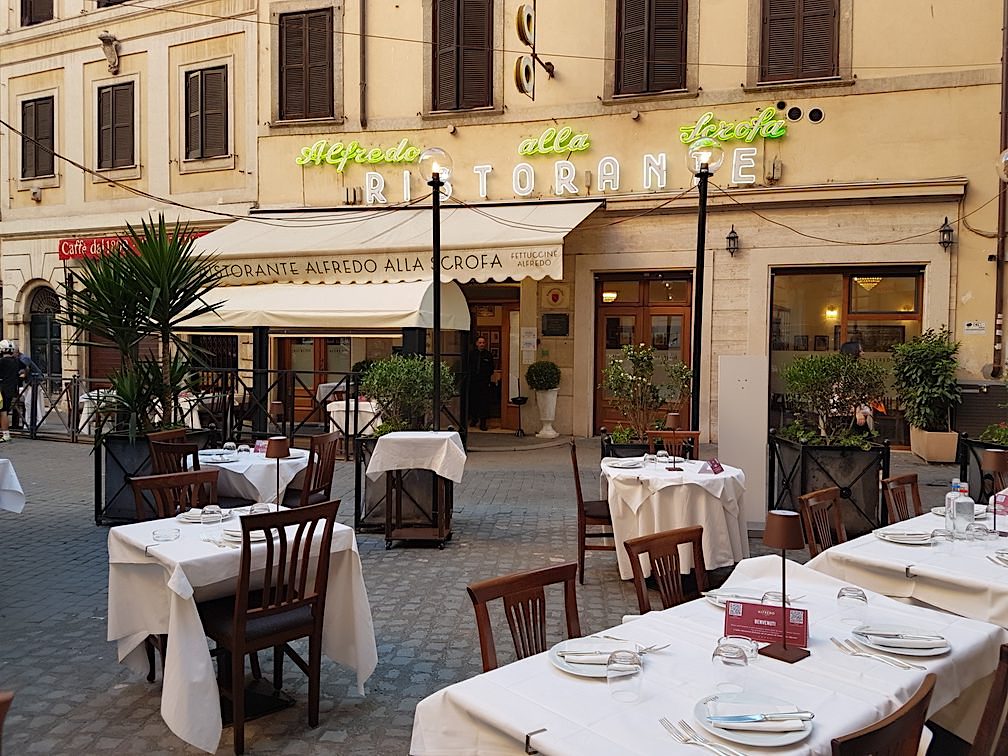
Roman
cookery on occasion uses butter in recipes, but
classic Roman pastas like spaghetti alla
carbonara, all’amatriciana, all’arrabiata
and cacio e
pepe do not. Alfredo Di Lelio went further:
His fettuccine
was made with an enormous quantity of eggs and
three kinds of flour; the butter
was a triple cream—the richest available—and the
Parmigiano-Reggiano was cut from the core of the
wheel. And that…was…it.
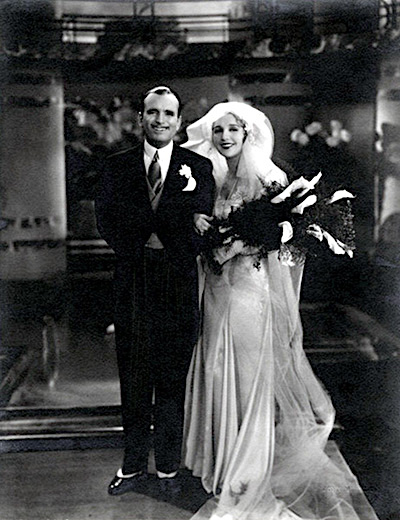 The dish
would have remained one among many on Alfredo’s
menu, and since World War I intervened, Rome was
not teeming with tourists until the Roaring
Twenties, when Americans, dying for booze and wine
unavailable back home during Prohibition, hopped
steamships and set sail for Europe. Among those
who traveled to Rome were the two biggest
Hollywood stars of the period, Douglas Fairbanks
and Mary Pickford (left), who were
traveling on their honeymoon in 1920. Dining at
Alfredo’s restaurant they
The dish
would have remained one among many on Alfredo’s
menu, and since World War I intervened, Rome was
not teeming with tourists until the Roaring
Twenties, when Americans, dying for booze and wine
unavailable back home during Prohibition, hopped
steamships and set sail for Europe. Among those
who traveled to Rome were the two biggest
Hollywood stars of the period, Douglas Fairbanks
and Mary Pickford (left), who were
traveling on their honeymoon in 1920. Dining at
Alfredo’s restaurant they 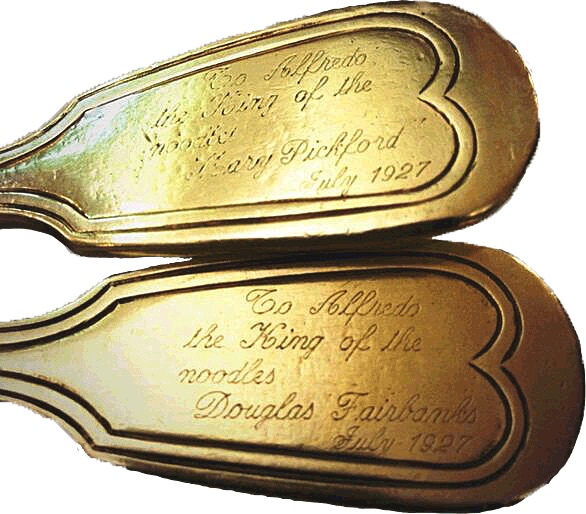 fell in love with his fettuccine
dish and dined at Alfredo’s daily, and, years
later, returned to
present the owner with a gold-plated spoon
and fork inscribed “To Alfredo the King of the
Noodles July 1927.”
fell in love with his fettuccine
dish and dined at Alfredo’s daily, and, years
later, returned to
present the owner with a gold-plated spoon
and fork inscribed “To Alfredo the King of the
Noodles July 1927.”
The international press picked up on this
item and spread the fame of Alfredo’s noodle dish
around the world. Within a year a recipe had
appeared in the United States, printed in The Rector
Cook Book by George Rector (who in 1939
reported Di Lelio had given the golden utensils to
be melted down for Mussolini’s war efforts).
World War II shuttered Rome’s restaurants
until the U.S. 5th Army liberated the city in June
1944. Two years later Alfredo sold the restaurant
on the Via della Scrofa to two of his waiters,
named Urbano and Ubaldo, who were permitted to
retain Alfredo’s name. But in 1950 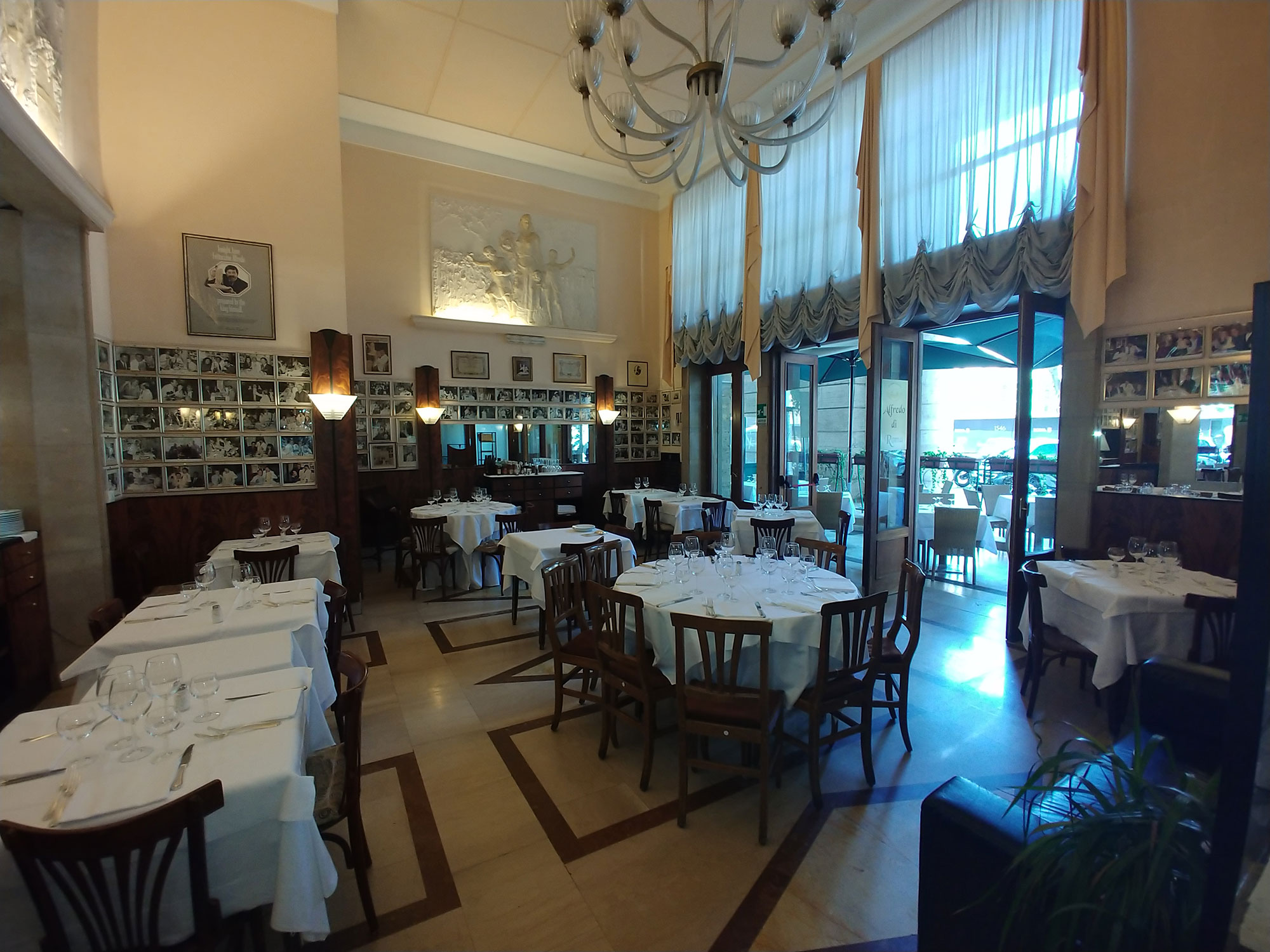 Alfredo gave his son
Armando—without whose birth there would be no
fettuccine all’Alfredo— a new restaurant in Rome
that they called, “Il Vero
Alfredo” (“the true Alfredo’s”) in the Piazza
Augusto Imperatore (left), where to this
day it is managed by Armando’s son Alfredo
(“Alfredo III”) with his sister Ines Di Lelio.
Alfredo II garnered enormous publicity by posing
himself and his noodles with show business stars
like Gary Cooper (below). The trademark to
the name “Alfredo’s the Original of Rome” was
bought by Guido Bellanca for a series of
restaurants under that name in the United States,
which flourished in the 1980s.
Alfredo gave his son
Armando—without whose birth there would be no
fettuccine all’Alfredo— a new restaurant in Rome
that they called, “Il Vero
Alfredo” (“the true Alfredo’s”) in the Piazza
Augusto Imperatore (left), where to this
day it is managed by Armando’s son Alfredo
(“Alfredo III”) with his sister Ines Di Lelio.
Alfredo II garnered enormous publicity by posing
himself and his noodles with show business stars
like Gary Cooper (below). The trademark to
the name “Alfredo’s the Original of Rome” was
bought by Guido Bellanca for a series of
restaurants under that name in the United States,
which flourished in the 1980s.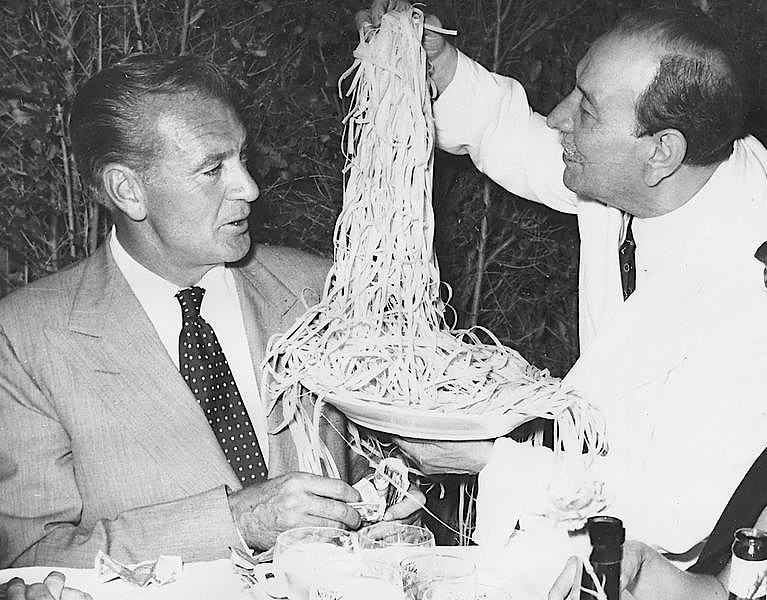
Both
of the Rome restaurants under the name Alfredo’s
are still open: the one on Via della Scrofa is now
run by Mario Mozzetti, who every February 7 hosts
National Fettuccine Alfredo Day with a big,
festive party and a soup kitchen for the poor. And
to this day the finest renderings of fettuccine
all’Alfredo are to be found at both restaurants,
however competitive they are. (They keep their
prices competitive.)
So how did other chefs elsewhere botch such
a perfect, simple dish? One could say it happened
in Hollywood, after the dish became so connected
to Fairbanks and Pickford on their return from
Rome. The problem was that no American (or
Italian-American) cook could possibly obtain the
same ingredients Alfredo had at his disposal. The
ground wheat flour for the pasta was not
available, and Italian eggs from a variety of
chicken breeds differ from those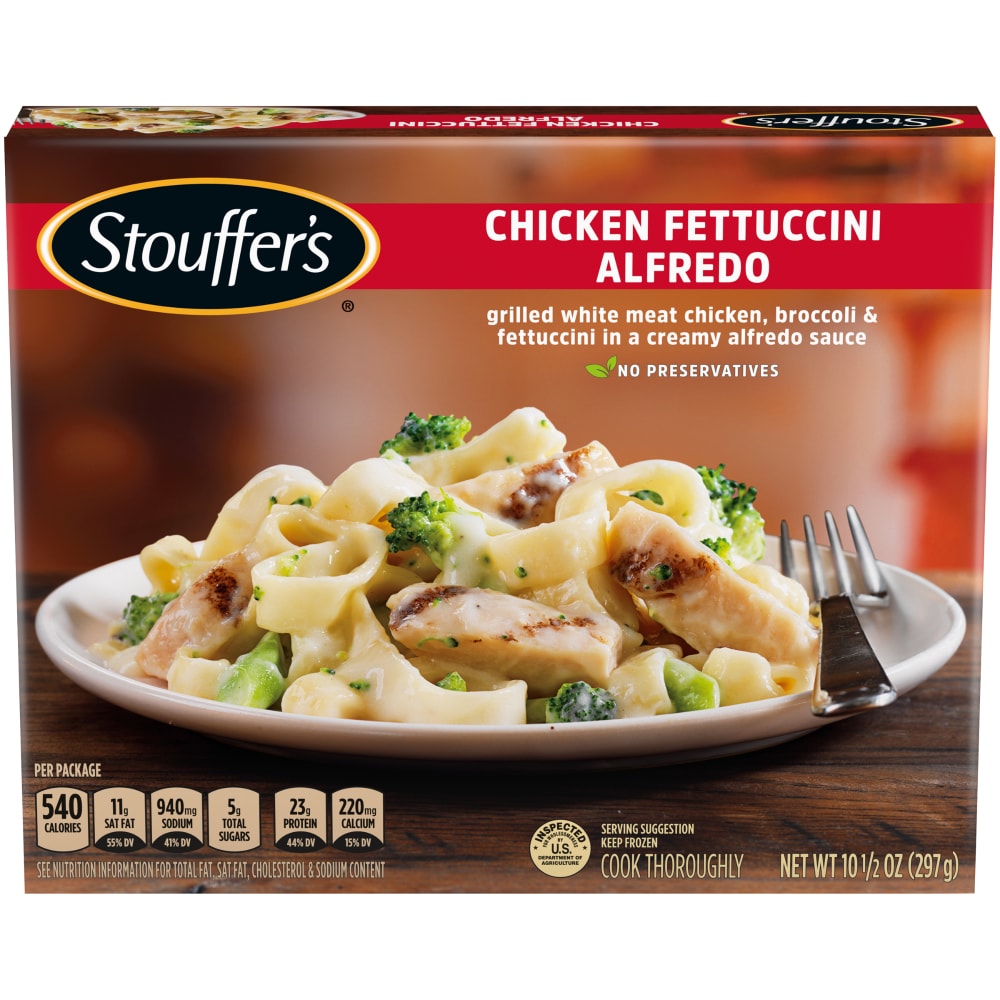 laid by American hens. The butter
here was not anywhere near as rich as it was
there, and, most important, Parmigiano-Reggiano
was not imported into the States until well after
World War II.
laid by American hens. The butter
here was not anywhere near as rich as it was
there, and, most important, Parmigiano-Reggiano
was not imported into the States until well after
World War II.
In order to make the dish, then, cooks
resorted to boosting the richness by adding heavy
cream, even a little flour to help thicken the
sauce. Then, of course, some cooks had to
elaborate on the dish by adding parsley. There’s
an Italian saying that “Parsley is like children.
It gets into everything,” which is not a
compliment. As time went on Italian food chains
like Olive Garden and Macaroni Grill started 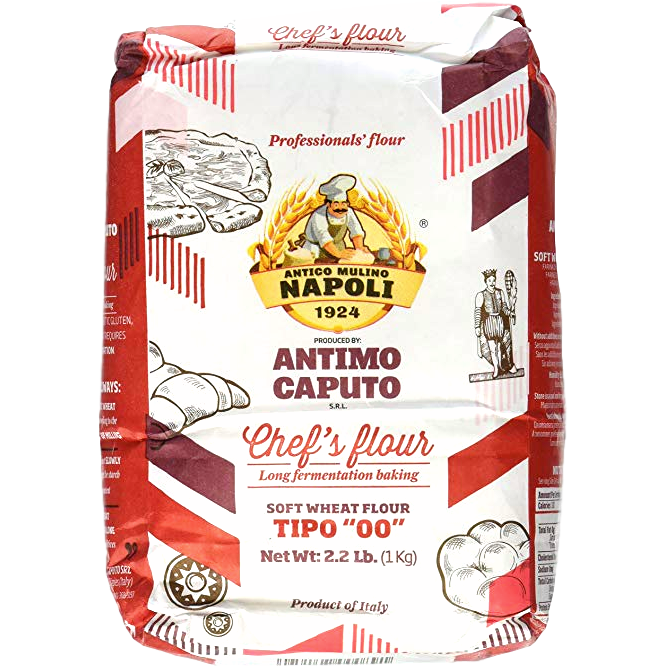 tossing in all sorts
of things, and the frozen food section of
supermarkets calls any number of items with an
oleaginous cream sauce “Alfredo.” You can even buy
a whole jar of the stuff, but it is about as close
to what Alfredo created back in 1914 as Annette
Funicello is to Sophia Loren.
tossing in all sorts
of things, and the frozen food section of
supermarkets calls any number of items with an
oleaginous cream sauce “Alfredo.” You can even buy
a whole jar of the stuff, but it is about as close
to what Alfredo created back in 1914 as Annette
Funicello is to Sophia Loren.
The snootier Roman restaurateurs who used
to bridle at American tourists asking for
fettuccine all’Alfredo would carp that it’s not
really a Roman dish, so they list it under “fettuccine
al burro”
(with butter) or "alla crema”
(with cream) for their American clientele.
So,
that’s the story. The good news is that you can
come pretty close to the original fettuccine
all’Alfredo without too many compromises.
First, find a recipe for 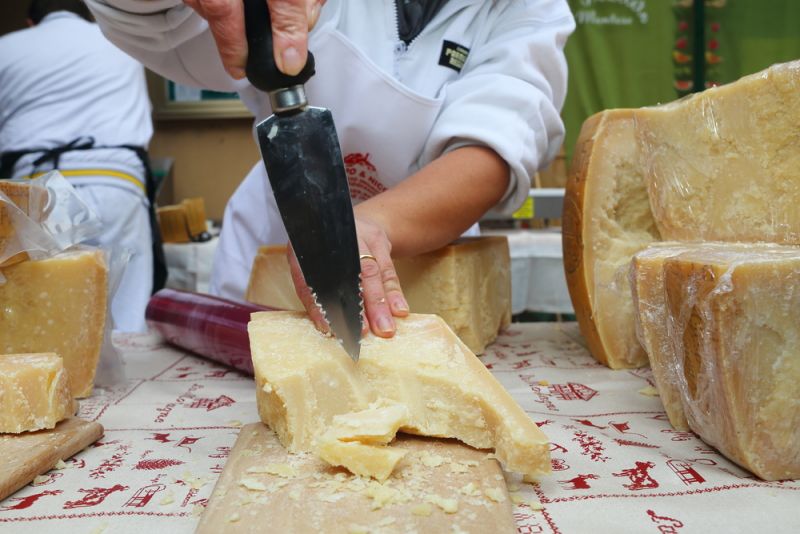 fresh
pasta—not dry—that uses plenty of eggs: one per
cup of flour—even adding an egg yolk or two. You
can now buy so-called superfine OO (“doppio zero”)
Italian flour, which is essential for texture;
even King Arthur sells it. Seek out the
finest aged Parmigiano-Reggiano available from an
Italian grocer or serious cheese store. From 24 to
36 months is a good age. Ask your cheese monger to
cut as much of a wedge as he is willing to close
to the core. And if he does not use a short,
wood-handled Parmigiano knife to cut the
Parmigiano (left), walk the other way.
fresh
pasta—not dry—that uses plenty of eggs: one per
cup of flour—even adding an egg yolk or two. You
can now buy so-called superfine OO (“doppio zero”)
Italian flour, which is essential for texture;
even King Arthur sells it. Seek out the
finest aged Parmigiano-Reggiano available from an
Italian grocer or serious cheese store. From 24 to
36 months is a good age. Ask your cheese monger to
cut as much of a wedge as he is willing to close
to the core. And if he does not use a short,
wood-handled Parmigiano knife to cut the
Parmigiano (left), walk the other way. 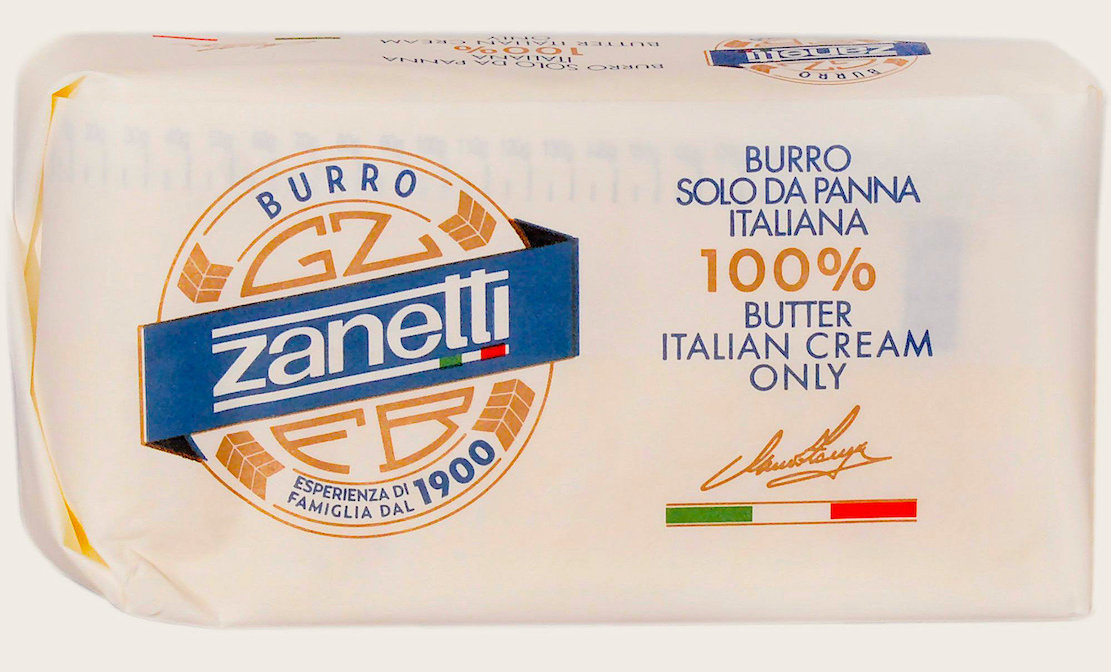 The quality of the unsalted butter
is essential. Various high-fat French butters are
fine, as is Kerrygold from Ireland; the best
American butter I know is made by Vermont Butter
and Cheese Company, but it's not easy to find and
goes for about $15 a pound. Zanetti, imported from
Italy in the fall and spring, is made with the
same milk as is used to make Parmigiano-Reggiano.
The quality of the unsalted butter
is essential. Various high-fat French butters are
fine, as is Kerrygold from Ireland; the best
American butter I know is made by Vermont Butter
and Cheese Company, but it's not easy to find and
goes for about $15 a pound. Zanetti, imported from
Italy in the fall and spring, is made with the
same milk as is used to make Parmigiano-Reggiano.
To get the perfect consistency of creamy
cheese and butter will take some practice, but the
recipe calls for you to boil the fresh pasta in
salted water for no more than a minute, in order
to keep it al
dente, or, as Italians say, in the time it
takes to say one Hail Mary. 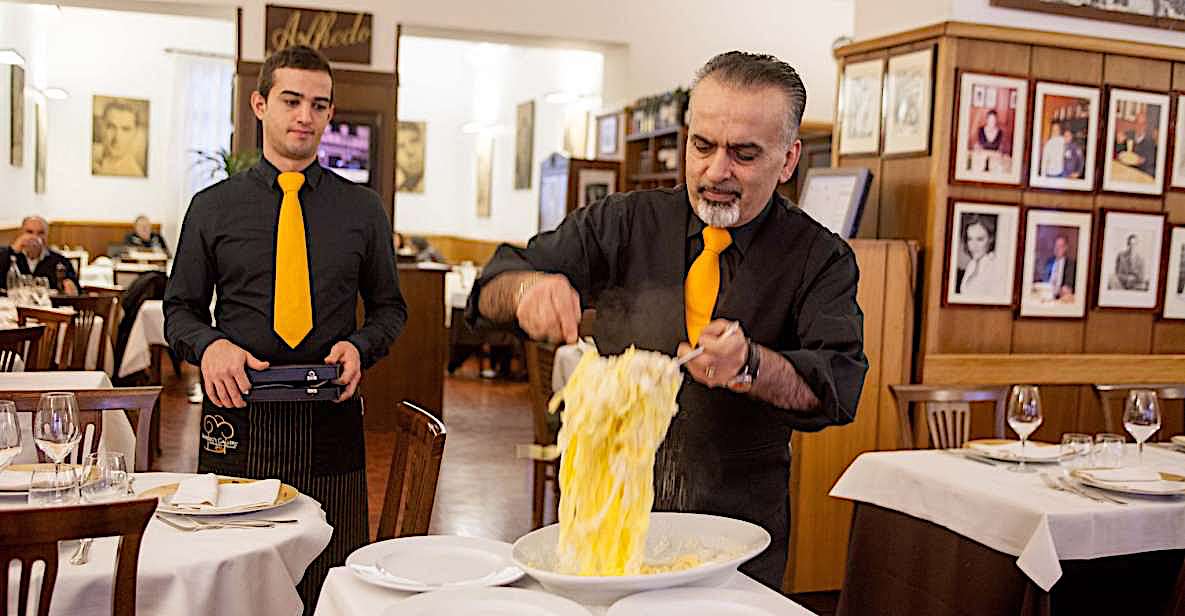 In a saucepan
melt the butter till just starting to sizzle, add
a handful of just ground Parmigiano and
immediately throw in the drained fettuccine. Add
another handful of cheese and keep folding the
ingredients together till thick and creamy. Put
salt, pepper and more grated Parmigiano on the
table, and serve pasta in heated pasta plates.
Tell your guests to eat immediately upon receiving
their plate. “Friends and fettuccine must be
warm,” goes an old saying.
In a saucepan
melt the butter till just starting to sizzle, add
a handful of just ground Parmigiano and
immediately throw in the drained fettuccine. Add
another handful of cheese and keep folding the
ingredients together till thick and creamy. Put
salt, pepper and more grated Parmigiano on the
table, and serve pasta in heated pasta plates.
Tell your guests to eat immediately upon receiving
their plate. “Friends and fettuccine must be
warm,” goes an old saying.
Fettuccine all’Alfredo cannot be made in
big batches and kept on the stove. It’s best to do
the final toss right at the table. If left sitting
around for too long you’ll get a lump of gluey
pasta.
And
if done right, with plenty of practice— and no
parsley!—you’ll have a dish that is perfectly
simple and simply perfect.
❖❖❖
AU ZA'ATAR
212-254-5660
By John Mariani
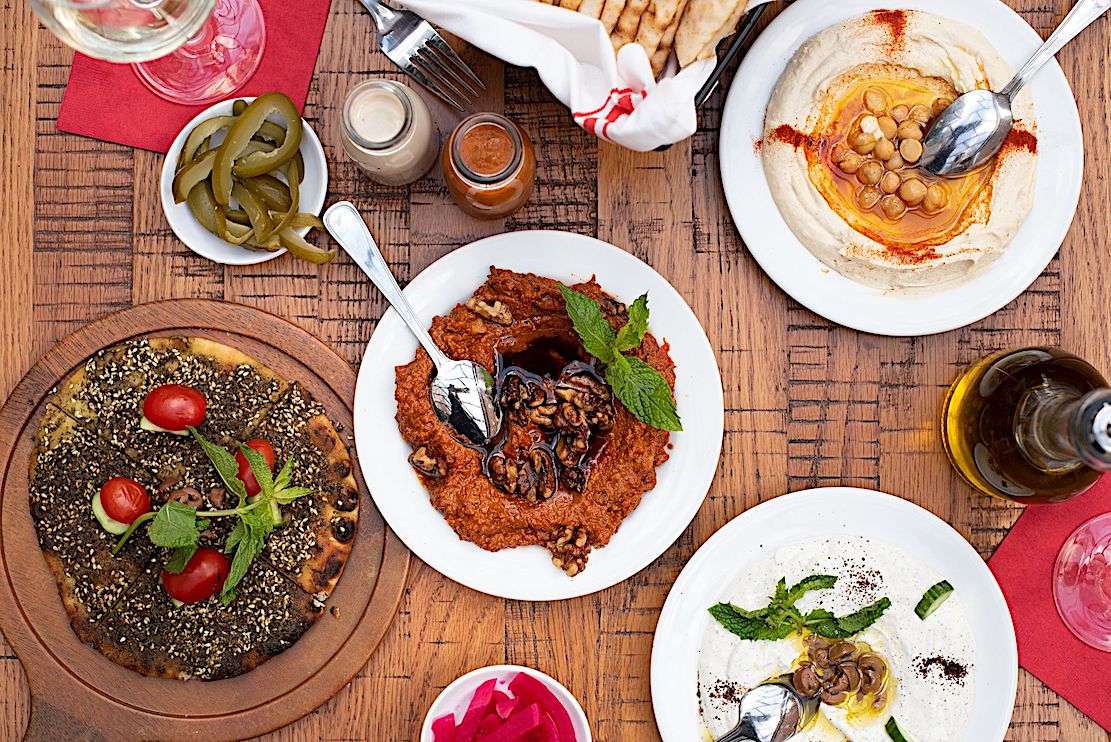
There are at least a dozen Lebanese
cookbooks in the market and about 20 Lebanese
restaurants in Manhattan alone, with many more
in pockets of the other boroughs. One of the
best and most successful has been Au Za’atar,
which was opened downtown on Avenue A back in
2014 by Tarik Fallous. Now, four months ago,
he expanded into the former premises of the
long-running Rosa Mexicano near the 59th
Street Bridge, and, while only operating
outdoors for the moment, it’s clearly a big
hit.
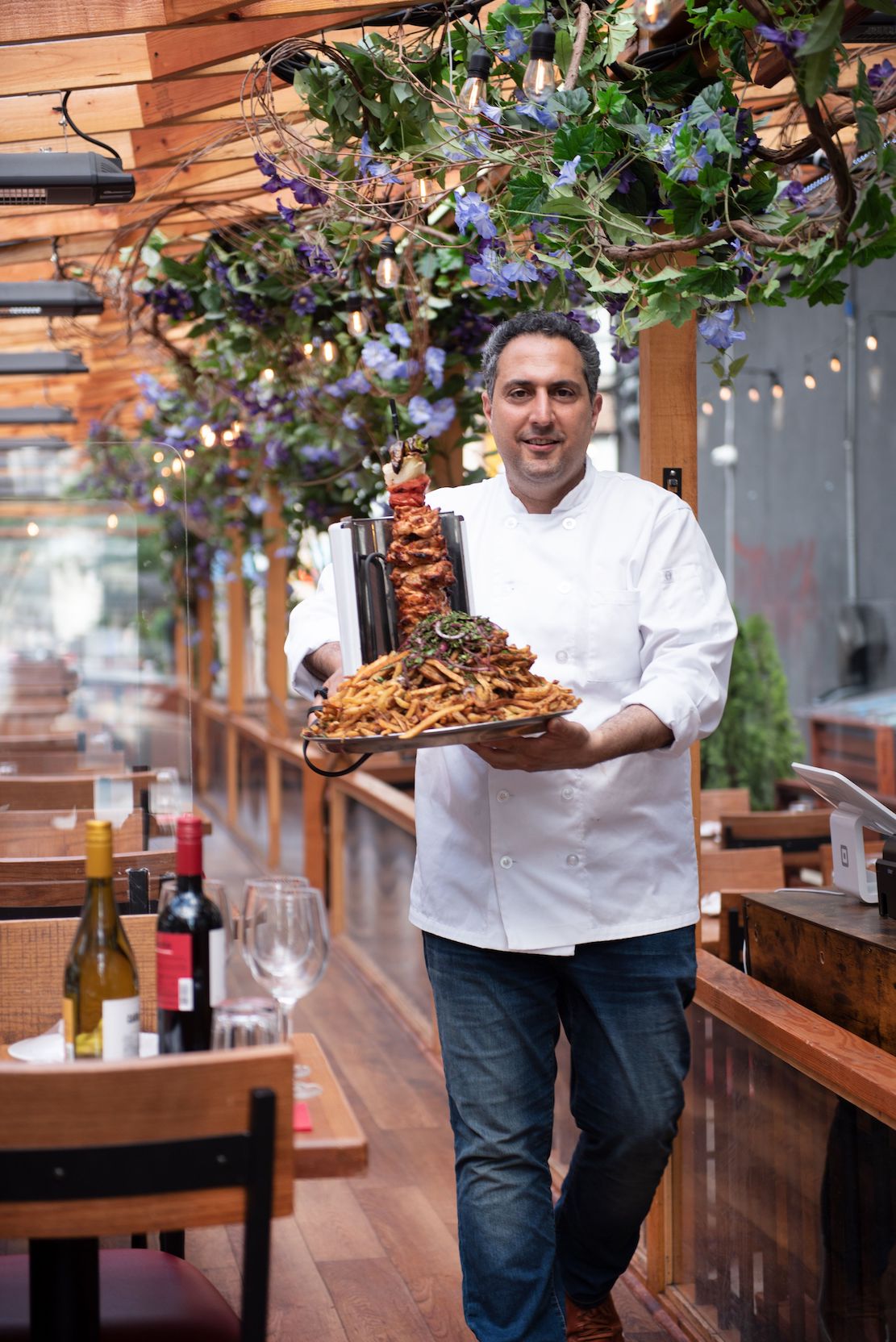 Fallous
(left) learned to cook from his mother,
Salwa, and his range is very deep
Fallous
(left) learned to cook from his mother,
Salwa, and his range is very deep 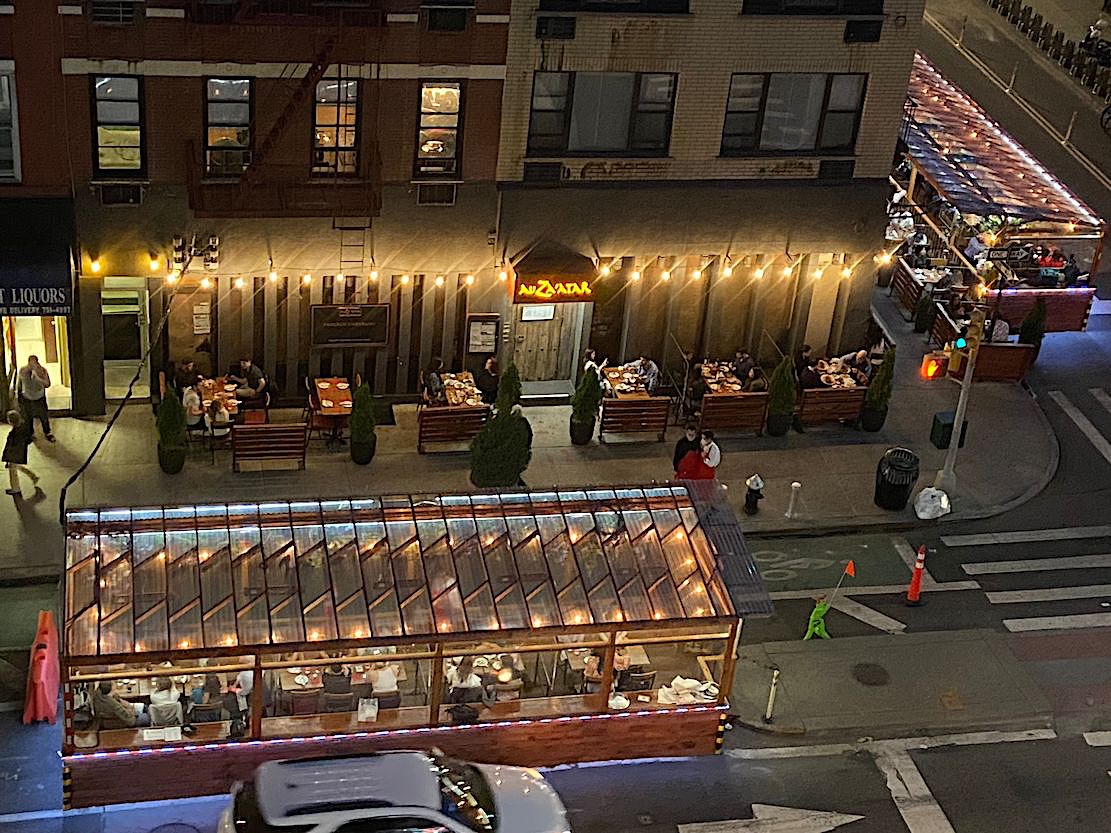 and
very broad in every category of Lebanese cuisine,
which is at least as rich in variety as Turkish.
The menu is long, though there is repetition in
various categories, and, as always with
Mediterranean cooking, the first course mezzes
are the most tantalizing. What distinguishes Au
Za’atar is what follows them, all of it buoyed
by basket after basket of fresh, smoky, puffy pita
bread. The word za’atar
refers to an herb mixture of dried wild thyme,
sesame seeds and sumac.
and
very broad in every category of Lebanese cuisine,
which is at least as rich in variety as Turkish.
The menu is long, though there is repetition in
various categories, and, as always with
Mediterranean cooking, the first course mezzes
are the most tantalizing. What distinguishes Au
Za’atar is what follows them, all of it buoyed
by basket after basket of fresh, smoky, puffy pita
bread. The word za’atar
refers to an herb mixture of dried wild thyme,
sesame seeds and sumac.
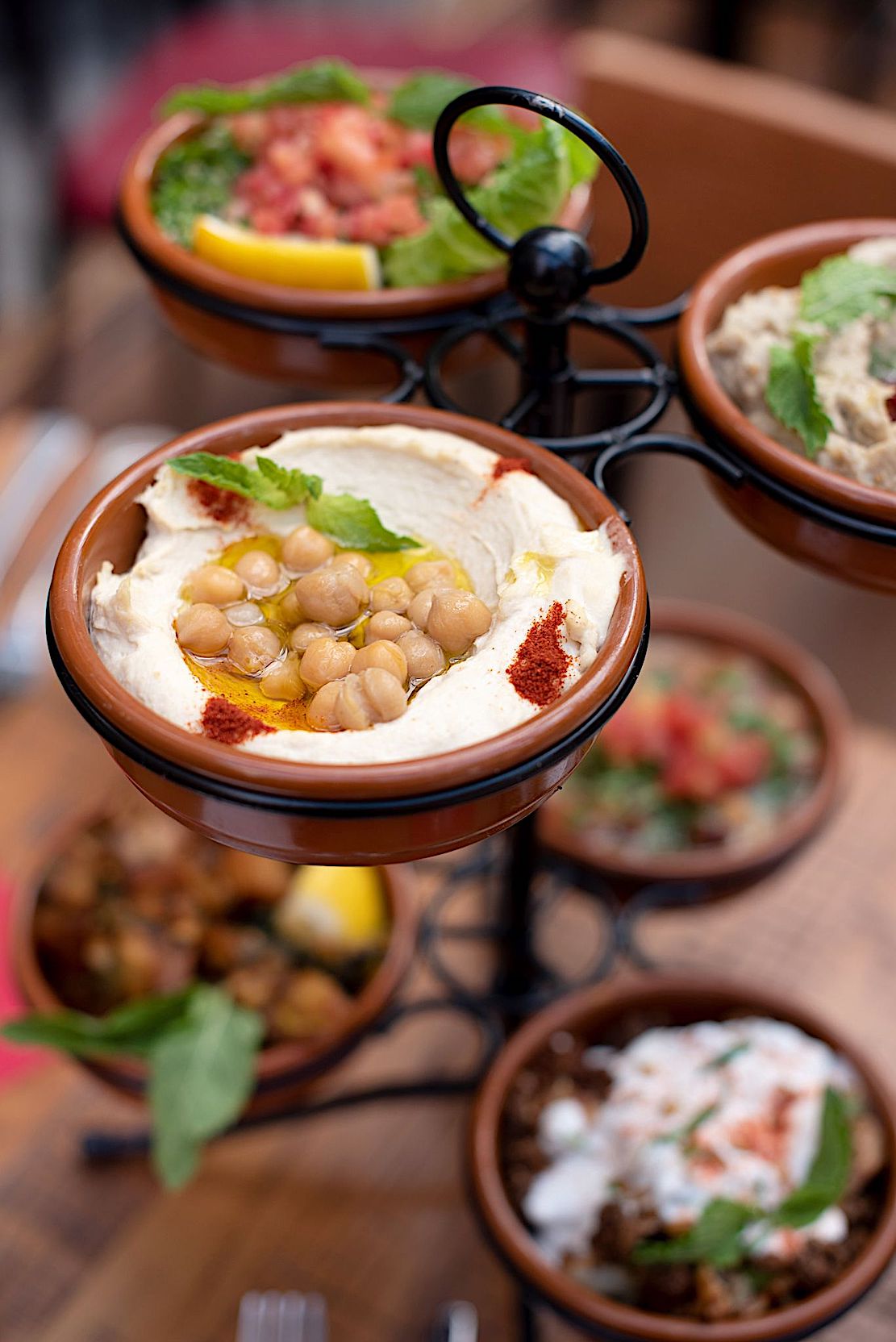 It’s
best to come with friends who will happily share
all the small plates and the dips like the
delicious hummus ($10), also in a spicy style, and
the spiced cauliflower called arnabeet
mekle ($14). A tabouli salad ($14.50) of
bulgur mixed with parsley, tomatoes, scallions,
mint, fresh lemon juice and olive oil is the
essence of summer. Beautiful oven-roasted beets
take on creaminess and tang ($13.50) with chèvre.
There is of course traditional falafel ($11) of
chickpeas, sweet onions, cumin and chopped
parsley. Aside from
It’s
best to come with friends who will happily share
all the small plates and the dips like the
delicious hummus ($10), also in a spicy style, and
the spiced cauliflower called arnabeet
mekle ($14). A tabouli salad ($14.50) of
bulgur mixed with parsley, tomatoes, scallions,
mint, fresh lemon juice and olive oil is the
essence of summer. Beautiful oven-roasted beets
take on creaminess and tang ($13.50) with chèvre.
There is of course traditional falafel ($11) of
chickpeas, sweet onions, cumin and chopped
parsley. Aside from 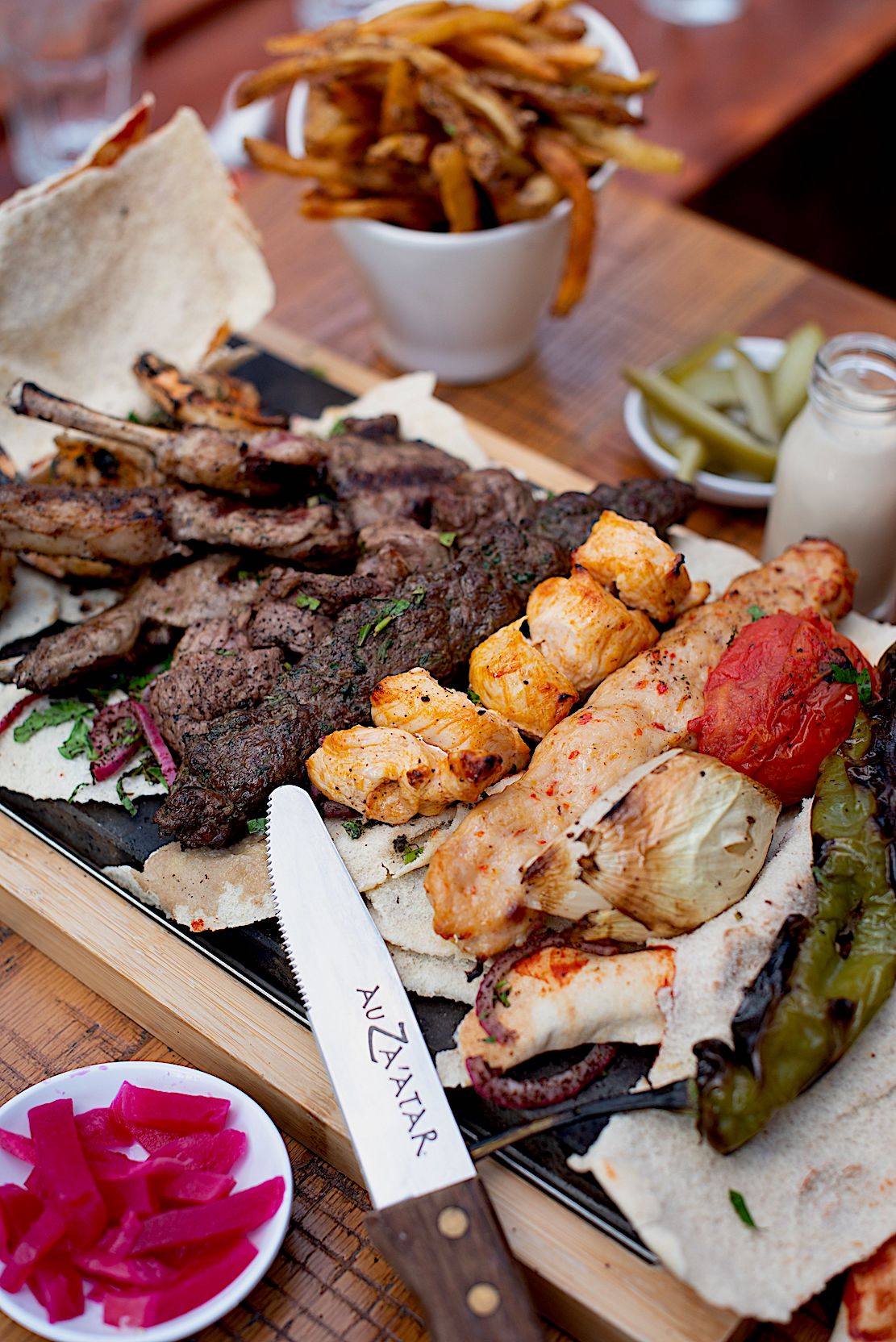 the pita bread
there are also some scrumptious flat breads manae’esh ($14).
the pita bread
there are also some scrumptious flat breads manae’esh ($14).
There’s lots more, so the best way to go is
with Au Za'atar’s Mezze Mix
Tray ($54)
or Mezze
& Dips Tray ($54). Fattet
Al-Betenjane ($17.50) is particularly
savory, a dish of eggplant with warm chickpeas and
crispy pita chips smothered with garlic-rich
yogurt sauce and sprinkled with sun-dried
cranberries, rose-red pomegranate seeds and pine
nuts. Batata
harra ($11.50) are sauteed spicy potato
cubes with cilantro, garlic and red pepper flakes,
while bemieh
bzeit ($14) is a sauté of
baby okra—not my favorite veg—in olive oil with
tomatoes, garlic and cilantro and makes them
special. Somewhere in the meal you should get the
sumac-dusted fried potatoes ($9) in a perfect
aïoli. The remarkable thing is that, using many of
the same spices, these individual dishes taste so
different yet are distinctly Lebanese, with
somewhat more bite than, say, Turkish or Persian
food.
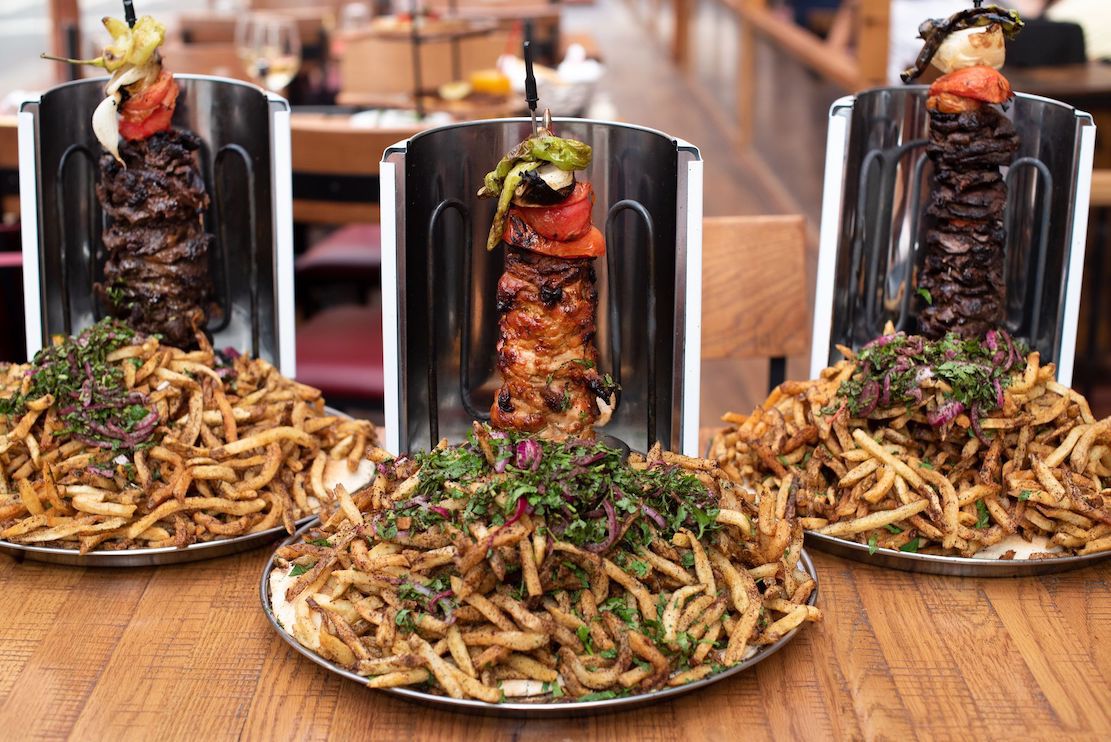 On to the main courses: There are a couple
of platters of grilled meats and makanek
beef sausages ($54 and $78) I’d recommend, and
there are various kabobs. I loved the hefty, thick
lamb shank ($29), a generous one, braised slowly
and suffused with an Armagnac prune sauce served
over red skin mashed potatoes and sweet
caramelized onions. Kibbi
kabaniyeh ($30) is finely ground beef
scented with mint and tossed with toasted pine
nuts, served with wonderfully suffused vermicelli
rice.
On to the main courses: There are a couple
of platters of grilled meats and makanek
beef sausages ($54 and $78) I’d recommend, and
there are various kabobs. I loved the hefty, thick
lamb shank ($29), a generous one, braised slowly
and suffused with an Armagnac prune sauce served
over red skin mashed potatoes and sweet
caramelized onions. Kibbi
kabaniyeh ($30) is finely ground beef
scented with mint and tossed with toasted pine
nuts, served with wonderfully suffused vermicelli
rice.
I confess that my ravenous desire to taste
so many dishes at Au Za’atar meant I did not
order—this
time—its “Original tableside Shawarma®️,” available
with chicken, lamb or beef ($78 or
$98), which comes to the table as a thick shaft of
meats to be carved off and served with those great
sumac fries.
I’ll be back.
Not that I was any longer hungry, but I
tried several desserts that were fairly dull by
comparison with everything else.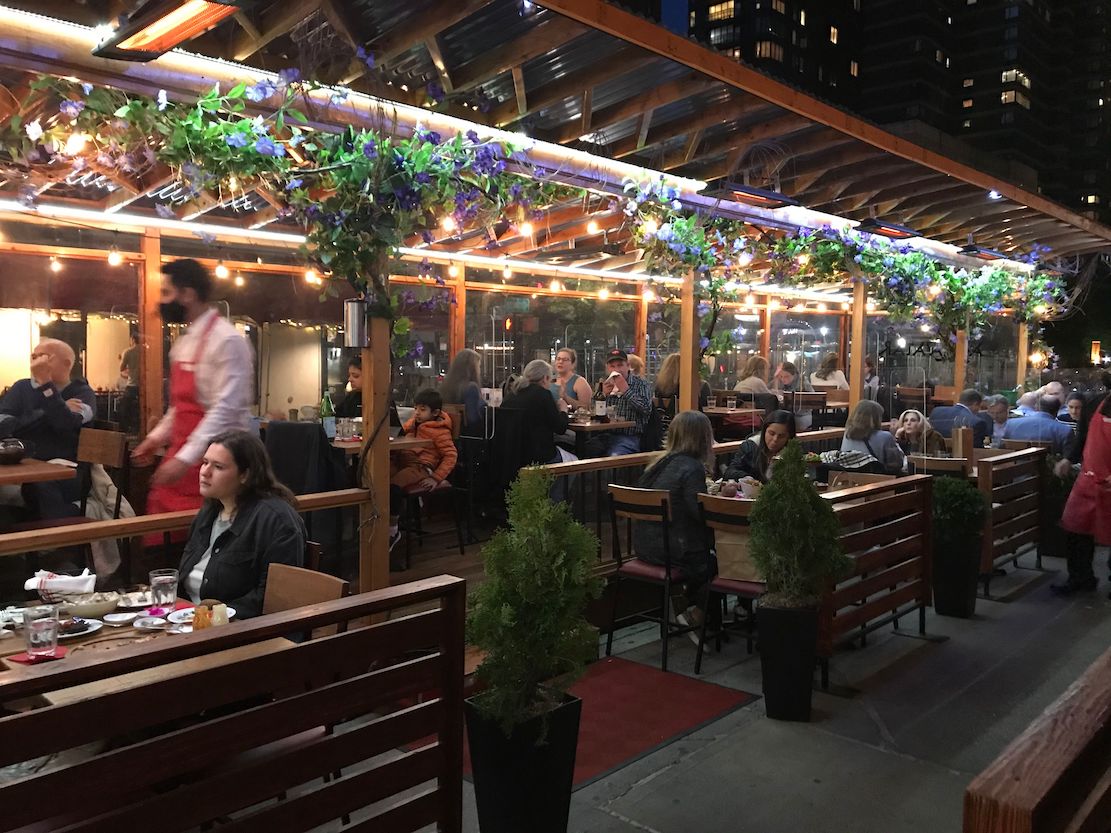
The wine list is very good, with plenty of
unusual bottlings at modest prices, including some
Lebanese wines (and beers) that go well beyond the
usual Château Musar (I’ve never known why it is so
expensive since there is so much of it around).
Château Wardy white and red are very good at a
much lower price. They also serve laban
ayran, a traditional salty
yogurt drink I can’t see enjoying with dinner.
As noted, the 120-seat terrace is where all
dining now takes place (indoors will be open
soon), with wooden walnut decks and lovely
flowered vines with partial glass windows. The
only off note is that one wall is set with
unsightly (closed) garbage dumpsters they really
should shield from view. But the crowd is very
happy to be outside, despite the rumble and noise
of eighteen-wheelers trying to get to the bridge.
Maybe Au
Za’atar’s menu is a bit too long for everything on
it to be first-rate, but I had no complaints about
a single dish I ordered, reminding me again of how
sophisticated and varied Lebanese cuisine really
is.
Open nightly for
dinner.
CAPONE’S
GOLD
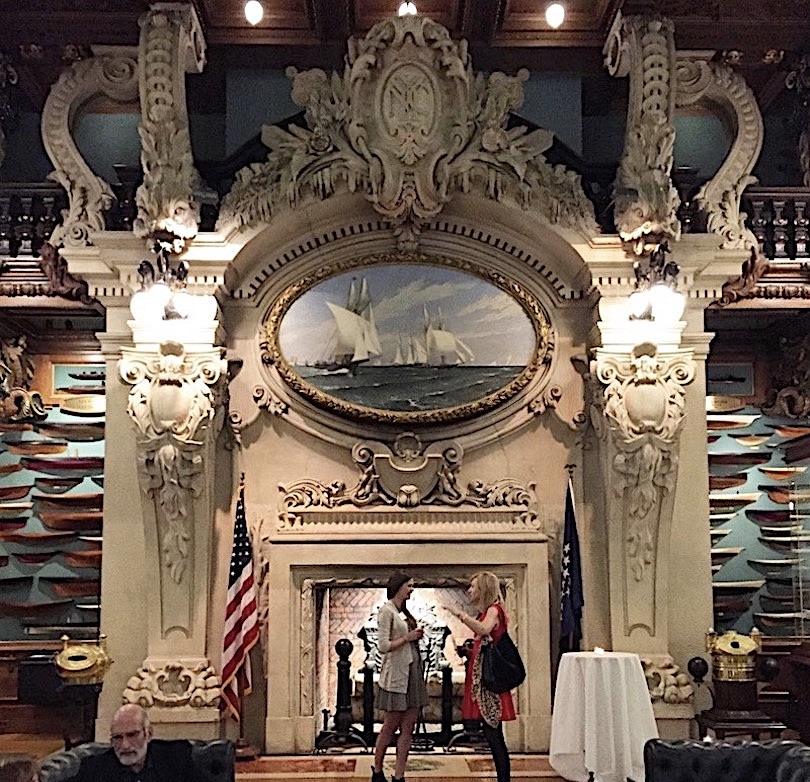
It
took a while for the reporter and the
ex-police officer to break through the red
tape at the highly officious headquarters of
the New York Yacht Club, which was located in
an ornate building dripping with stylized
concrete seaweed, with bay windows fashioned
like a galleon’s aftercastle, which housed the
captain’s quarters. Inside
was the great Model Room, full of more than
150 ship’s models lined up in glass cases.
 After
waiting twenty minutes, Katie and David were
greeted by a middle-aged man in a blue blazer,
gray slacks, button-down shirt and a necktie
with nautical flags on it.
After
waiting twenty minutes, Katie and David were
greeted by a middle-aged man in a blue blazer,
gray slacks, button-down shirt and a necktie
with nautical flags on it.
“Miss Cavuto and Mr. Greco? I’m Edward
Prus. I
run the archive here. I
understand you wish to find out information
about some old yachts?”
Katie spoke first, taking out her
handheld voice recorder. “Yes,
we’re working on a project about Al Capone, and
we understand he owned at least two yachts in
his lifetime.”
“Oh, yes,” said Edward Prus. “I know
about them, the Acania and the Islamorada. They’re
quite well known in yachting circles because of
Mr. Capone’s notoriety. But
there was also a third, named the Reomar,
which was built in 1924 for a car magnate named
Ransom Olds, who founded both the Oldsmobile and
REO car brands.
The name `Reomar’ combines `REO’
with `mar,’ for sea, so it was a seagoing REO. Very
fine boat.”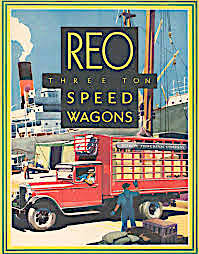
“I’ve heard a little about the Acania,”
said David. “What can you tell us about it?”
Edward Prus guided them over to a table
in the club’s beautiful library and asked them
to have a seat. “Give me a moment, please.”
Katie and David looked around at the
baronial room of polished wood book cabinets and
leather sofas, thinking how out of water Al
Capone would have felt in such surroundings and
how unlikely that he would ever have been
accepted for membership.
Edward Prus came back to the desk with
several books and file folders.
“Now,
this,” he said, pulling a photo from a folder,
“is the Acania (below) and it’s
actually the twin of another boat, both built by
a New York banker named Arthur Olson Wheeler.”
He said that the first was built in
Delaware by Pusey and Jones in 1929, the second
in 1930 by Consolidated Shipbuilding in New
York.
Both companies were known for their
elegant power yachts, some of them up to two
hundred feet in length. But
the Depression hit the industry hard. During the
war they built subchasers for the Navy, but
Consolidated went out of the boatbuilding
business around 1958.
David sensed that
Edward Prus could ramble on for hours on the
arcane subject of yacht building, so he tried to
steer him back to the Capone connection.
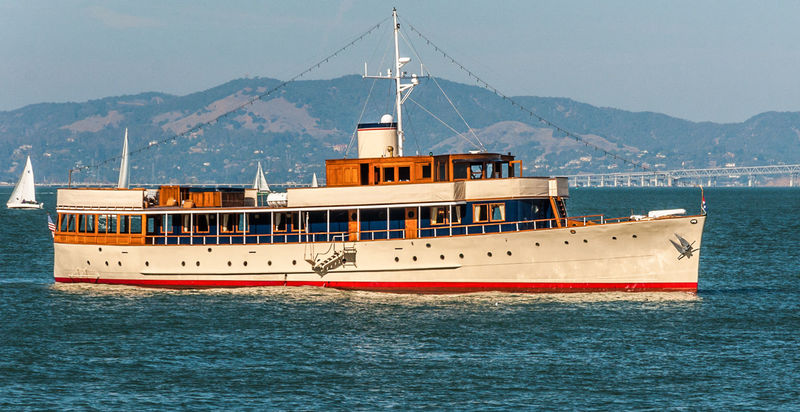 “There’s
no contractual proof the second boat was ever
sold to or owned by Capone,” Prus said, “though
it’s oddly coincidental that the next owner, the
Walgreen family . . . .”
“There’s
no contractual proof the second boat was ever
sold to or owned by Capone,” Prus said, “though
it’s oddly coincidental that the next owner, the
Walgreen family . . . .”
“Walgreen of the drug stores?” asked
Katie.
“Yes, indeed. They bought the Acania
in 1934.”
“That’s the year Al Capone went to
prison,” said David.
“Really?”
said Edward Prus. “How interesting.”
“But why would a respected New York
banker build and sell a yacht to Al Capone?”
Katie asked.
“I have no idea,” Prus answered, “except
bankers during the Depression made deals they
might not have in better times. The
clues to Capone’s ownership lie in what is
verifiable about the design of the boat (below),
which was very elegant, complete with a marble
fireplace and teak paneling with hidden
recesses. There was also a hidden space that
opened to a room complete with a fold-down bar.
I’m told that one owner found some Champagne
bottles in a secret compartment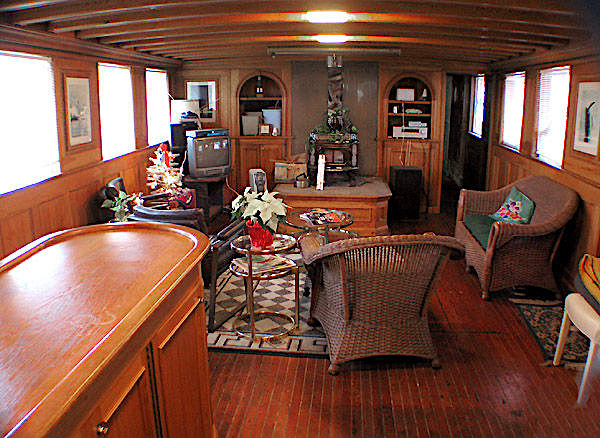 in as late as the 1980s.”
in as late as the 1980s.”
“So you said that the yacht was sold to
the Walgreens family when Capone went to
prison?” asked Katie, glancing at David, who
nodded. “Apparently,”
said Prus, “and then, during World War II Acania
was commissioned by the Navy as a submarine
echo finder. Ultimately she went to a scrap yard
in Miami but I understand a fellow from
California bought it just last year.”
Katie and David knew they’d struck out in
thinking the Acania could have been
used by Capone as a gold transport because the
yacht had already been sold before the heist had
even occurred.
“And the other boats?” asked David.
“Ah, yes, the Islamorada (below).
That was another beauty, almost a hundred feet
long. It
was built in 1912 in New England, christened the
Savannah. Now
that one we know was definitely owned by Al
Capone. It was quite well known as a party boat
during Prohibition, and Capone had a lot of
complaints about it from the local authorities
in Miami. He
might have hung on to that one while he was in
prison, but it, too, was commandeered by the
Navy and used for training exercises. It
seems to have foundered off Bermuda and sank
around 1943.”
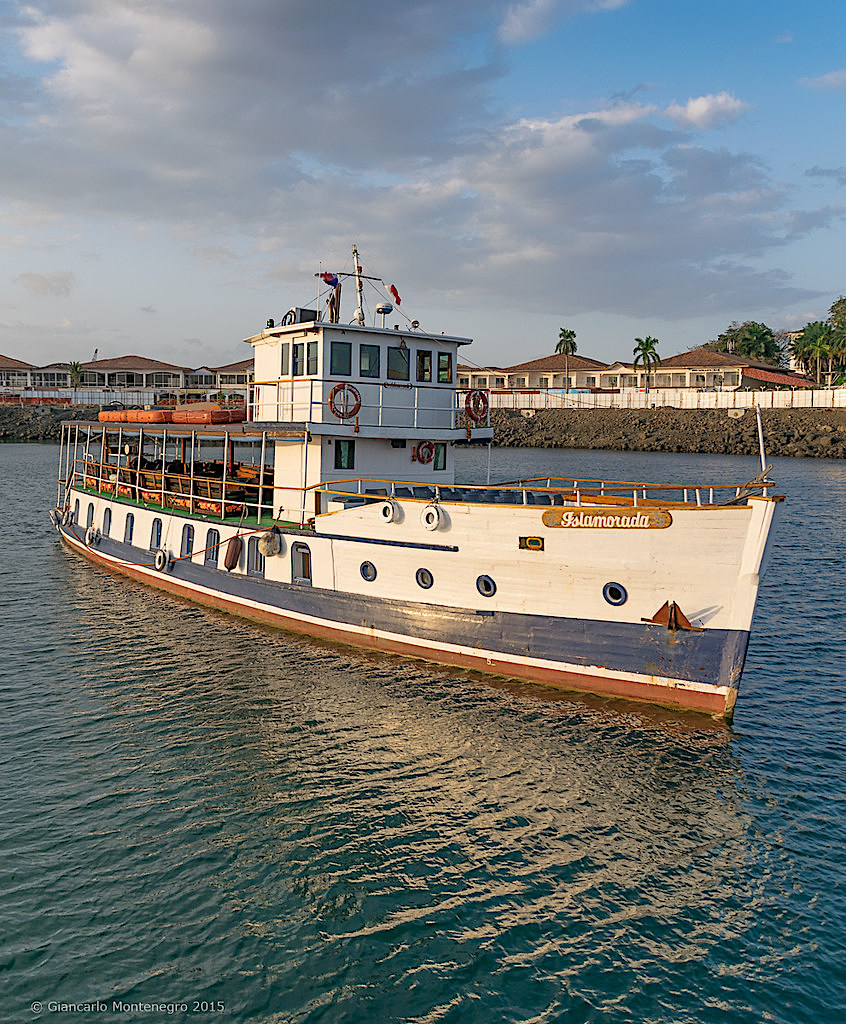 Another
strike-out.
So Mr. Spickler had been wrong about the
Acania. The
Islamorada (left) might have been
the other one he’d mistaken for Capone’s
post-war boat.
Another
strike-out.
So Mr. Spickler had been wrong about the
Acania. The
Islamorada (left) might have been
the other one he’d mistaken for Capone’s
post-war boat.
“And the Reomar?” asked Katie.
Prus said that Capone bought that boat
from Olds at the same time he purchased the Palm
Islands estate, but after he was sent to prison
the Reomar (below) was
confiscated. It was quite a yacht, with sixteen
staterooms. After the war it was left to decay
in a Navy boatyard and was only rescued from
being broken up in 1974 by a Texas oil man, who
refitted it quite splendidly. He
re-named it the Celika.
“I believe it’s docked in Corpus
Christi,” said Prus. “Would you like to see
photos of all the yachts?”
“No, thank you very much,” said Katie.
“But we thought Capone owned yachts after he got
out of prison.”
“It’s very possible that he did, but I’d
have to know their names and registry to help
you any further.”
Katie and David left the New
York Yacht Club and went to a nearby coffee
shop.
“What do we do now?” asked Katie. “I
thought the boats were a great clue to the
puzzle.”
“Well,” said David, “just because we
found out those particular boats don’t work
within our time scheme, it doesn’t mean the
boats Capone had after the war didn’t play a
part in hiding the gold.”
“But, David, I thought we already agreed
that the gold had to be securely socked away
somewhere as soon as possible after the robbery. After
the war, why care about his pleasure boats?”
“You’re right, you’re right. I keep
forgetting that after the war the trail more or
less goes nowhere.”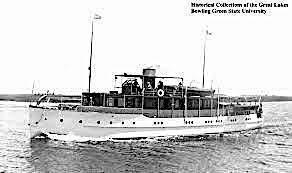
“Arrrgh!” roared Katie. “This
is so damn frustrating.”
“Well, I guess we don’t need to go to
Mystic or Annapolis then.”
“Guess not. Where should we go?”
“How about Brazil?” asked David, “So your
editor can’t find us.”
“Uh-uh. We already spent his money.”
“Oh, right,” said David, pretending to
look dumb.
“So nothing in your research showed up
any names of Capone’s rumrunning boats?"
“Nope. I’m sure he got rid of them the
day Prohibition stopped.”
“Makes sense. But he
certainly could have gotten hold of one easily
enough in 1934 to get the gold out of the
country.”
“So we’re back to which country?”\
“Okay, let’s think,” said David. “Let’s
use the process of elimination: We nixed South
America and Cuba, right? And
although he had his connections in Bimini and
the Bahamas, most of them probably dried up
after booze became legal again. Same
with Canada. And by then I suspect the British
were playing nice with the American government
with regard to keeping gold in the U.S.”
Katie leaned her head back against the
wall and looked at her watch.
“What time is it? Five-thirty. Hm, since
we missed lunch, how about we have an early
dinner and give our fevered brains a rest?”
“You talked me into it. Any
suggestions?”
“Lots.
Midtown is my turf, where all the
publishers’ offices are located. What kind of
food you feel like?”
“I always think better over a good
steak.”
“Okay, follow me.”
© John Mariani, 2015
❖❖❖
THE PAST, PRESENT AND FUTURE OF
CHÂTEAU DUCRU-BEAUCAILLOU
By John Mariani
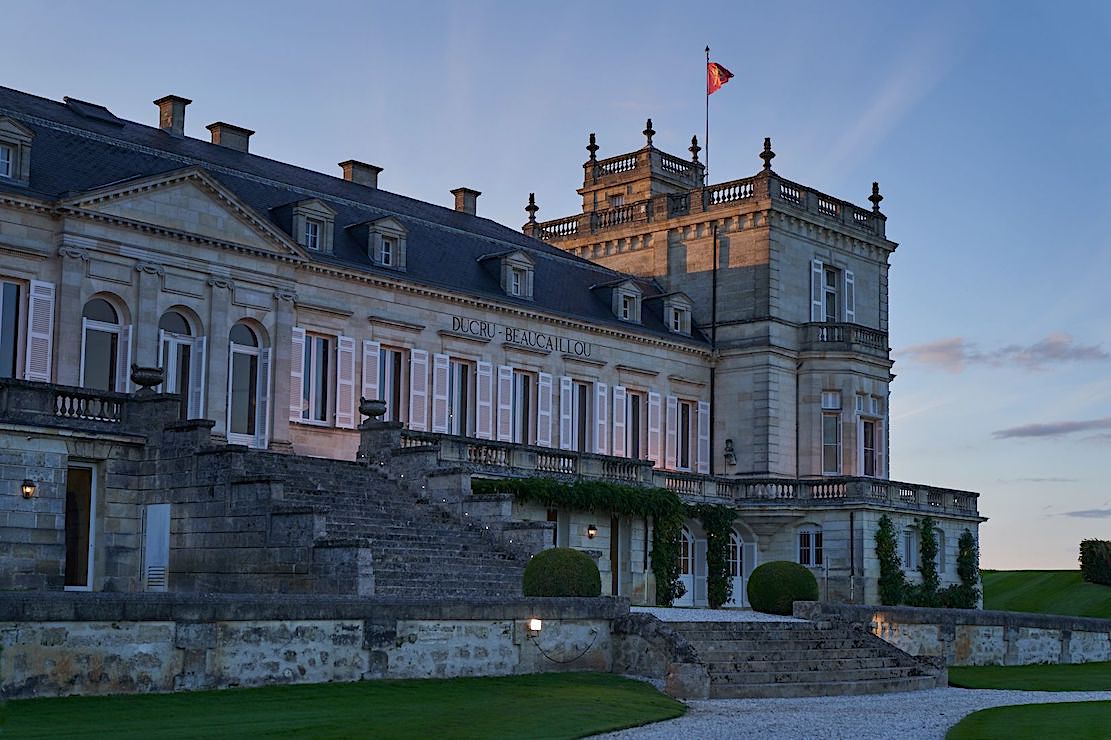
Château
Ducru-Beaucaillou has a long history going back to
before the French Revolution and several owners
since. In 1941 Francois Borie bought the estate
and made improvements with successive family
members in control. The family also owns
Château Grand-Puy-Lacoste. Disaster struck in 1988
when the cellars suffered from TCA contamination,
ruining the 1988, 1989 and 1990 vintages. Today
the estate is owned and managed by Bruno
Borie. The production of the wine totals
about 7-9,000 cases, as a blend of 70% Cabernet
Sauvignon and 30% Merlot within the St.-Julien
appellation.
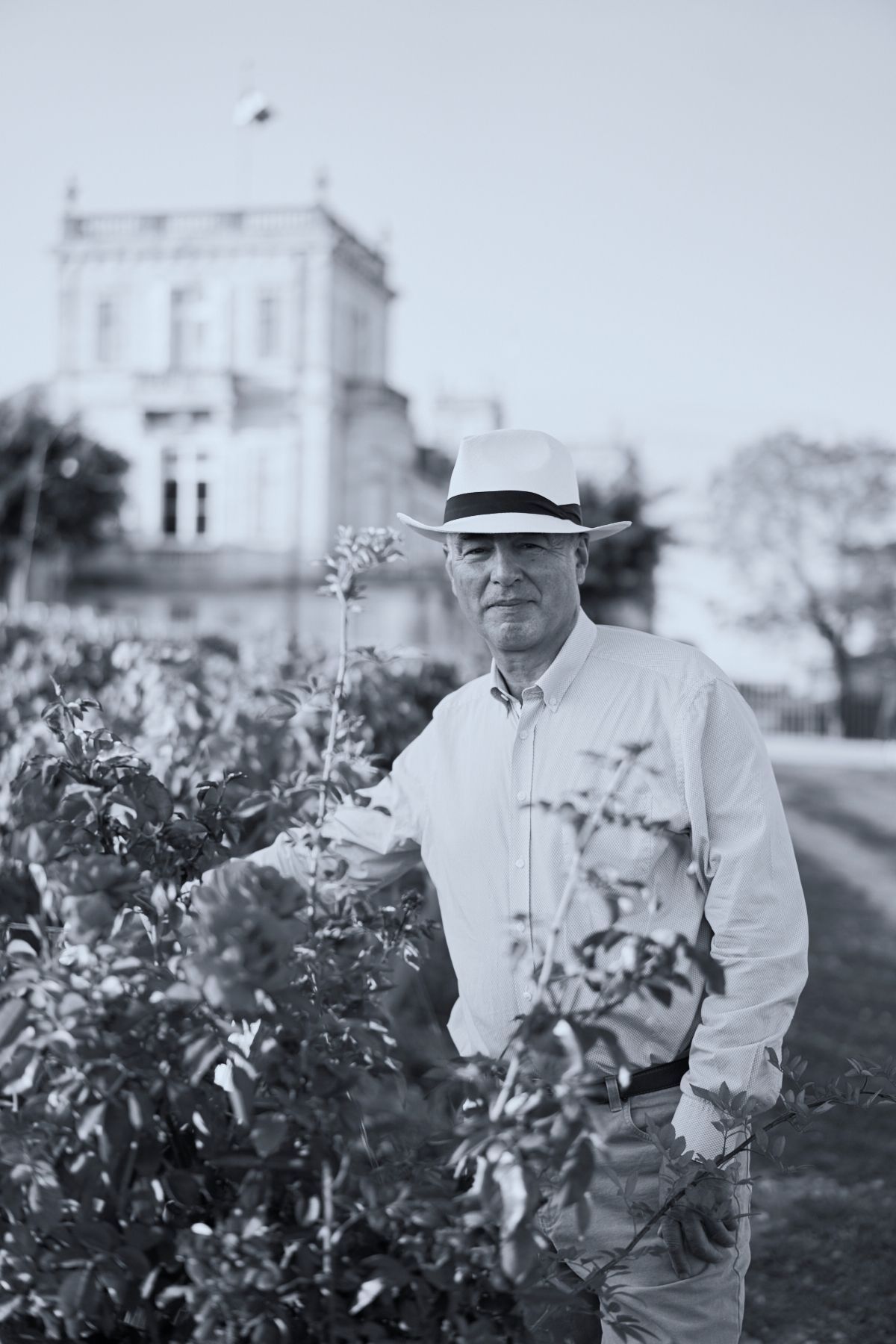 I spoke with Borie (left) about how
Ducru today is balancing tradition with modern
techniques.
I spoke with Borie (left) about how
Ducru today is balancing tradition with modern
techniques.
Tell me a little of
your own background. How many family members are
involved?
I was born and raised at
the estate and I have always been immersed in this
country landscape and lifestyle, in the vineyards
and the pastures, cattle and all. I basked in the
fascinating environment of the cellars, where the
transmutation of the grape juice into wine, and then
the slow maturation of the young wine into these
magical elixirs takes place. From a young age, my
father encouraged me to travel to discover the
world, and most importantly to learn English, which
was essential as we were often visited by English
and American buyers and connoisseurs. I asked my
father to send me to the US, and I benefited from
many exciting trips to California, notably in the
wineries and vineyards that were just starting to
take off. After my studies, I worked for a Bordeaux
wine exporter and traveled a
lot throughout the U.S. and also throughout Asia,
which was just starting to open to the consumption
of wine. My brother François Xavier has his own
property in Pauillac, Château Grand Puy Lacoste. My
mother and sister are part owners at
Ducru-Beaucaillou, however, they are not involved in
the operations and management of the estate.
When did DB begin
its rise to eminence?
In 2020 we celebrated the
300th anniversary of the property and, with ups and
downs, it has always enjoyed a great prestige.
Bertrand Ducru, owner in the 19th century, had it
recognized and prominently positioned in the 1855
classification. The Johnstons, very powerful
Anglo-Scottish merchants, were owners at the end of
the 19th and beginning of the 20th, and worked
intensively in the vineyards and on the wine quality
while simultaneously giving it international status.
In the 1960s, my father gave Ducru- Beaucaillou an
exceptional place on the Bordeaux podium, thanks to
his great efforts to increase the quality of the
wine. I took the reins in 2003 and, inspired by my
father’s efforts, I continue to implement techniques
and fine-tune our approach in an uncompromising
quest to achieve the very best from our blessed
terroirs. The 2003, then the 2005, the 2009 and 2010
were each outstanding successes and undoubtedly
helped to raise our reputation. But undeniably, the
2018, 2019 and 2020 have garnered some of our
highest.
What sets it apart
from other Bordeaux? What is the terroir?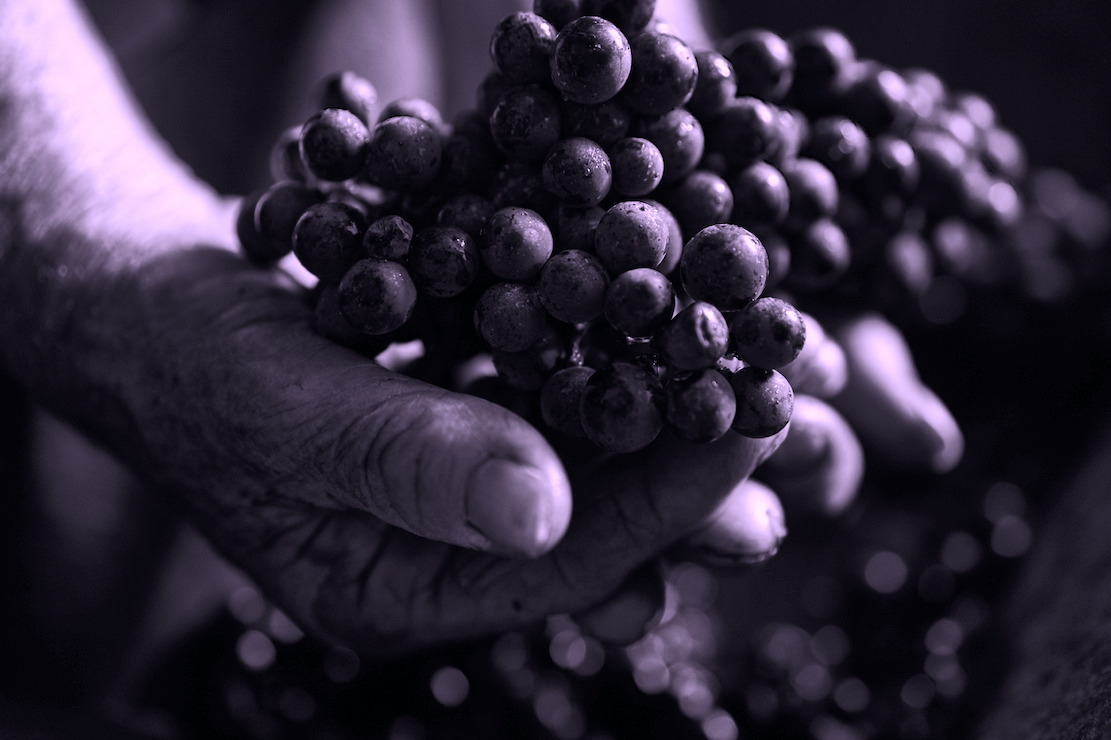
Ducru Beaucaillou is
situated in the Saint Julien appellation, in the
heart of the Médoc, where Cabernet Sauvignon reigns
supreme. The estate dominates the large Gironde
estuary, and as the name of the property “Beau
Caillou” (“beautiful stones”) implies, the vineyard
soils are composed of deep Günzian gravels.
The Ducru-Beaucaillou terroir bestows on us with
many advantages:
our well-aerated slopes that rise from the
Gironde enable us to avert spring frosts. Our slopes
of Günzian gravel soils permit adequate drainage
during heavy rains, and the subsoil reserves provide
needed water during periods of drought. Finally,
proximity to the Atlantic Ocean and to the Gironde
estuary moderate the temperatures with cool nights
during the heat of summer.
How did the estate
survive during two world wars?
For WWI, as a family, we
remember that our paternal grandfather Francis and
his brother Marcel, as well as our maternal
grandfather André, miraculously survived in the
cesspool of Verdun, thrown regularly under tons of
shells and bombs, amid the bursts of machine guns
with their brothers in arms, in assaults that were
as sterile and vain as they were murderous.
We also remember that
despite the war, the property had to continue,
somehow, to function thanks to the great efforts of
the wives of the brave men at war, and that
their 1916 was a rich and powerful vintage; which one
even wondered, at the time, if it was not too
strong. The only bottle of Ducru-Beaucaillou 1916
that I was able to taste was a few years ago, and it
was spectacular.
Concerning WWII, my grandfather,
veteran of WW1, was too old, my father too young, to
go to war. My
father quickly contracted a severe pleurisy that was
not cured under war circumstances and weakened him
considerably. Everything was missing to maintain the
vineyard, to make and mature the wines, and export
to markets, which represented the base of the wine
business, was closed! Regarding the château, like
most, it had been occupied by German officers, who did
not cherish red wine and therefore did not empty the
cellars! My grandfather who had fought them in
Verdun hated them, as did the rest of the family,
and they lived very poorly in these conditions of
severe defeat and the humiliating occupation.
How do you balance
tradition with modernity?
We are constantly trying to
find the best solution, the best technical route to
achieve this objective. Whether it is about
re-implementing ancestral practices that might have
been abandoned for such and such a reason or whether
it is about the latest scientific discoveries or
technological innovations. We are guided by the
taste of our wines and therefore the satisfaction of
our consumers, their aging capacity and the benefits
for our collectors, the preservation (or the
improvement) of our terroirs and ecosystems and the
heritage of the future generations, the well-being
of our teams in the cellars and vineyards and the
social strength of our company. Social and
Environmental Responsibility indeed guides us here.
You will find below our motto, written by our teams,
that outlines our philosophy. Science and innovation
are key and today, in the vineyards and cellars,
digitization, robots, and artificial intelligence
each help us to make better decisions. We have
created a R&D department, led by two highly
educated women, both experienced agronomists and
oenological engineers, to help us to research all
options available to us.
How has climate
change impacted Bordeaux? 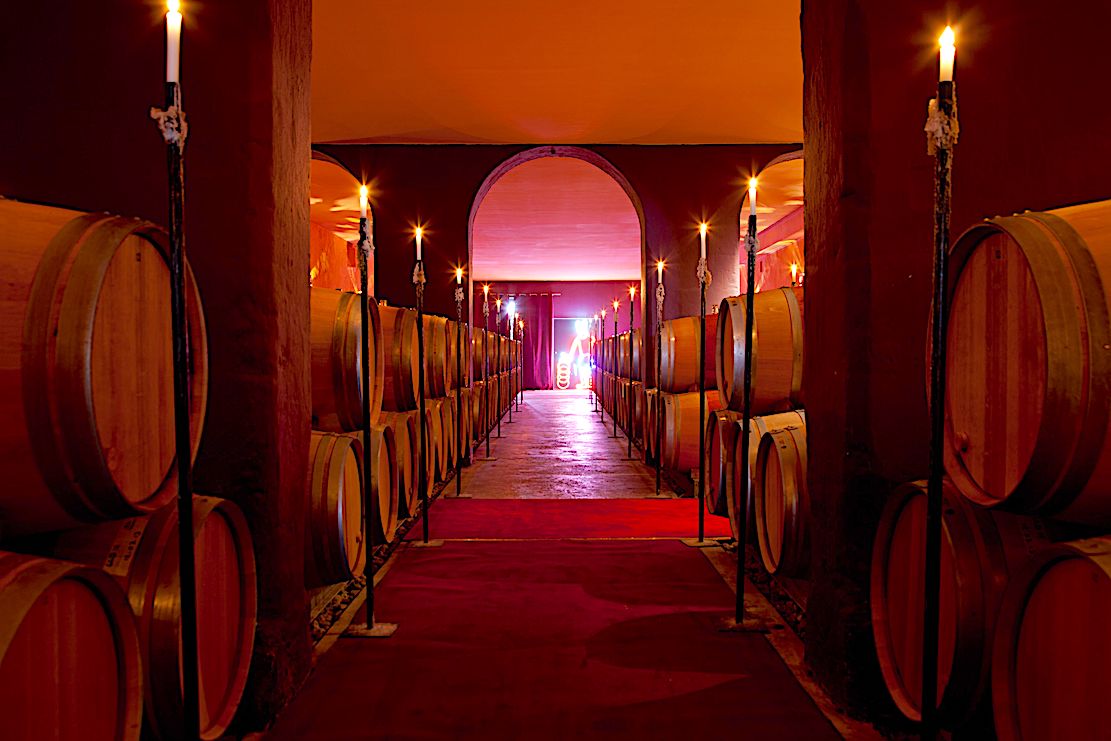
Overall, favorable climate
conditions combined with technical advancements and
manicured care provided to each individual vine have
resulted in more frequent high-quality vintages in
Bordeaux. Notably, the warmer temperatures have
enabled us, on the left bank, to attain perfect
ripeness in Cabernet Sauvignon grapes in most
years; Cabernet is a thick-skinned, late-ripening
variety that requires a lot of accumulated heat and
sunlight hours to fully ripen. As such, with the
warmer summers, the fruit is richer and more
concentrated with longer length, and the thick
skins, which ripen during the final phase, can fully
ripen, giving deeply colored wines with high levels
of extremely fine-grained, ultra-silky tannins. This
has also allowed us to widen the drinking window of
our wines. Specifically, because of this smooth
texture as well as the purity and precision in wine
making, we can start to enjoy Ducru-Beaucaillou as
early as three years old, and the high concentration
of tannins and anthocyanins ensure a long cellaring
potential, guaranteeing decades of pleasure.
The major challenge of global warming is the
unpredictable, extreme weather patterns it brings.
For example, for us in the Médoc, periods of heavy
rain significantly increase the risk of cryptogamic
diseases, notably downy mildew, while spring frosts
and late season hail can both be detrimental to the
vine and its fruit. As a result, we rely heavily on
the reactivity and extreme competence of our
technical teams to mitigate and reduce the risks of
these weather hazards.
How have sales been
impacted during the pandemic?
At Ducru-Beaucaillou, we
sell 100% of our wines as Futures through La Place
de Bordeaux, a complex internal marketplace based on
an allocation system unique to Bordeaux, where our
wines are sold while they are still aging in barrels
in our cellars, a year before they are bottled. In
2020 (for the 2019 vintage), we dropped our price
significantly in consideration of the global
pandemic. The wines were sold just after the first
confinement, and we sold out in hours to our
distributors around the globe. The wines will be
available in the marketplace early next spring.
The 2020 vintage was sold as Futures in June
this year. 2020 is a superior vintage, and is a very
special one for us, as we marked our 300th
anniversary with one of the best wines we have ever
produced, and a commemorative packaging. I am
thrilled to announce that our wines were sold within
two hours of their release.
Did restaurants stop
buying when they were closed by Covid?
Of course, we deeply regret
the great challenges the pandemic has brought to our
friends in the restaurant industry, especially the
sommeliers who do an extraordinary job of
recommending and presenting our wines to their
clientele.
As you can imagine, the dynamics of the market have
shifted during the pandemic. As expected, there has
been a significant drop in purchases from
restaurants; however, this has been compensated for
by other channels, notably through specialty retail
wine shops, and with a huge growth in online sales,
as domestic consumption increased exponentially
during the pandemic, particularly for fine wines.
Do you see
significant technology changes coming to Bordeaux?
Ampellography, yeasts, fermentation tanks, use of
barrels, cork stoppers?
Bordeaux is, and has always
been, a global leader in research and development
for wine production. Notably, the University of
Bordeaux is one of the top research centers in the
world for all subjects related to both viticulture
and winemaking. Furthermore, most of the top
châteaux in the region are very invested in
research and development, and as such, many new
technologies are pioneered in Bordeaux. In Bordeaux,
we respect tradition for the overall winemaking and
style, while integrating new technologies that
enable us to continually improve the quality of our
nectars. Technical
Director Emmanuel Bonneau and his team continually
push the boundaries of quality, constantly
questioning, assessing and evaluating every choice
and option available in every step of the production
process. 
To illustrate, we are conducting extensive
internal assessments of corks, fermentation vats,
and aging vessels, which includes rigorous
measurements and blind tastings. Based on our
extensive research, we are currently replacing our
fermentation vats with new high tech wooden vats
that enable us to do very long, gentle extractions,
while measuring and recording every possible measure
along the way. In contrast, after experiments with
various aging vessels, including clay amphoras, we
have decided to continue aging our wines in 100%
certified 225L French oak barrels for 18 months,
with staves that have been seasoned for a minimum of
6 years.
Are you concerned
about the global rise—much of it deliberate—in
higher alcohol in wines, 14.5% and more?
To date alcohol has not
been a concern, as the levels remain in harmony with
the other components of the wine. Certainly, alcohol
levels have risen as a result of global warming but
also as a result of intensive care in the vineyard
(leaf & grape thinning) giving healthier &
perfectly exposed clusters with lower yields and
production volumes.
For us, global warming at this stage has not
had a negative impact. At Ducru-Beaucaillou, alcohol
levels vary every vintage and remain within reason.
The alcohol is simply a reflection of the weather of
each vintage; 2018 was a solar vintage, while 2020
was warm and dry with cool nights and their alcohol
levels vary to reflect this. For us, vintages when
the alcohol levels have been higher reflects the
weather of the vintage, and is not a deliberate
choice! We carefully pick each plot by hand over a
period of 2-4 weeks, based on the balance and
ripeness of the fruit, including skin, or phenolic
ripeness, and the freshness of the berries. Our
objective is to have a harmonious balance, with a
perfect convergence of fruit concentration giving
great breadth, tannins
endowing perfectly mastered power, alcohol and
acidity that are seamlessly integrated.
Any of John Mariani's books below may be ordered from amazon.com.
 The Hound in Heaven
(21st Century Lion Books) is a novella, and
for anyone who loves dogs, Christmas, romance,
inspiration, even the supernatural, I hope you'll find
this to be a treasured favorite. The story
concerns how, after a New England teacher, his wife and
their two daughters adopt a stray puppy found in their
barn in northern Maine, their lives seem full of promise.
But when tragedy strikes, their wonderful dog Lazarus and
the spirit of Christmas are the only things that may bring
his master back from the edge of despair.
The Hound in Heaven
(21st Century Lion Books) is a novella, and
for anyone who loves dogs, Christmas, romance,
inspiration, even the supernatural, I hope you'll find
this to be a treasured favorite. The story
concerns how, after a New England teacher, his wife and
their two daughters adopt a stray puppy found in their
barn in northern Maine, their lives seem full of promise.
But when tragedy strikes, their wonderful dog Lazarus and
the spirit of Christmas are the only things that may bring
his master back from the edge of despair. WATCH THE VIDEO!
“What a huge surprise turn this story took! I was completely stunned! I truly enjoyed this book and its message.” – Actress Ali MacGraw
“He had me at Page One. The amount of heart, human insight, soul searching, and deft literary strength that John Mariani pours into this airtight novella is vertigo-inducing. Perhaps ‘wow’ would be the best comment.” – James Dalessandro, author of Bohemian Heart and 1906.
“John Mariani’s Hound in Heaven starts with a well-painted portrayal of an American family, along with the requisite dog. A surprise event flips the action of the novel and captures us for a voyage leading to a hopeful and heart-warming message. A page turning, one sitting read, it’s the perfect antidote for the winter and promotion of holiday celebration.” – Ann Pearlman, author of The Christmas Cookie Club and A Gift for my Sister.
“John Mariani’s concise, achingly beautiful novella pulls a literary rabbit out of a hat – a mash-up of the cosmic and the intimate, the tragic and the heart-warming – a Christmas tale for all ages, and all faiths. Read it to your children, read it to yourself… but read it. Early and often. Highly recommended.” – Jay Bonansinga, New York Times bestselling author of Pinkerton’s War, The Sinking of The Eastland, and The Walking Dead: The Road To Woodbury.
“Amazing things happen when you open your heart to an animal. The Hound in Heaven delivers a powerful story of healing that is forged in the spiritual relationship between a man and his best friend. The book brings a message of hope that can enrich our images of family, love, and loss.” – Dr. Barbara Royal, author of The Royal Treatment.
 |
The Encyclopedia of American Food and Drink by John F. Mariani (Bloomsbury USA, $35) Modesty forbids me to praise my own new book, but let me proudly say that it is an extensive revision of the 4th edition that appeared more than a decade ago, before locavores, molecular cuisine, modernist cuisine, the Food Network and so much more, now included. Word origins have been completely updated, as have per capita consumption and production stats. Most important, for the first time since publication in the 1980s, the book includes more than 100 biographies of Americans who have changed the way we cook, eat and drink -- from Fannie Farmer and Julia Child to Robert Mondavi and Thomas Keller. "This book is amazing! It has entries for everything from `abalone' to `zwieback,' plus more than 500 recipes for classic American dishes and drinks."--Devra First, The Boston Globe. "Much needed in any kitchen library."--Bon Appetit. |
"Eating Italian will never be the same after reading John Mariani's entertaining and savory gastronomical history of the cuisine of Italy and how it won over appetites worldwide. . . . This book is such a tasteful narrative that it will literally make you hungry for Italian food and arouse your appetite for gastronomical history."--Don Oldenburg, USA Today. "Italian
restaurants--some good, some glitzy--far
outnumber their French rivals. Many of
these establishments are zestfully described
in How Italian Food Conquered the World, an
entertaining and fact-filled chronicle by
food-and-wine correspondent John F.
Mariani."--Aram Bakshian Jr., Wall Street
Journal.
"Equal parts
history, sociology, gastronomy, and just
plain fun, How Italian Food Conquered the
World tells the captivating and delicious
story of the (let's face it) everybody's
favorite cuisine with clarity, verve and
more than one surprise."--Colman Andrews,
editorial director of The Daily
Meal.com. "A fantastic and fascinating
read, covering everything from the influence
of Venice's spice trade to the impact of
Italian immigrants in America and the
evolution of alta cucina. This book will
serve as a terrific resource to anyone
interested in the real story of Italian
food."--Mary Ann Esposito, host of PBS-TV's
Ciao
Italia. "John Mariani has written the
definitive history of how Italians won their
way into our hearts, minds, and
stomachs. It's a story of pleasure over
pomp and taste over technique."--Danny Meyer,
owner of NYC restaurants Union Square
Cafe, The Modern, and Maialino.
|
 |
 |
 |
 |
 |
 |
 Everett Potter's Travel Report:
Everett Potter's Travel Report: 
 Eating Las
Vegas JOHN CURTAS has been covering
the Las Vegas food and restaurant scene
since 1995. He is the co-author of EATING LAS
VEGAS – The 50 Essential Restaurants (as
well as the author of the Eating Las
Vegas web site: www.eatinglasvegas.
He can also be seen every Friday morning as
the “resident foodie” for Wake Up With the
Wagners on KSNV TV (NBC) Channel 3 in
Las Vegas.
Eating Las
Vegas JOHN CURTAS has been covering
the Las Vegas food and restaurant scene
since 1995. He is the co-author of EATING LAS
VEGAS – The 50 Essential Restaurants (as
well as the author of the Eating Las
Vegas web site: www.eatinglasvegas.
He can also be seen every Friday morning as
the “resident foodie” for Wake Up With the
Wagners on KSNV TV (NBC) Channel 3 in
Las Vegas.
MARIANI'S VIRTUAL GOURMET
NEWSLETTER is published weekly. Publisher: John Mariani. Editor: Walter Bagley. Contributing Writers: Christopher Mariani,
Robert Mariani, Misha Mariani, John A. Curtas, Gerry Dawes, Geoff Kalish,
and Brian Freedman. Contributing
Photographer: Galina Dargery. Technical
Advisor: Gerry
McLoughlin.
If you wish to subscribe to this
newsletter, please click here: http://www.johnmariani.com/subscribe/index.html
© copyright John Mariani 2021

